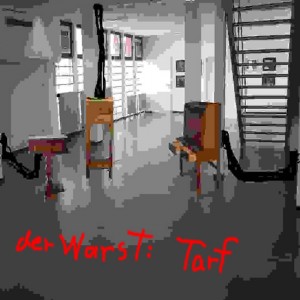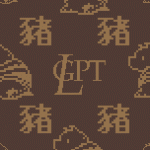 der Warst chimes in with the second hot Piggy Tracker release this week. It’s part of project168 Part 4 and you can nab it here.
der Warst chimes in with the second hot Piggy Tracker release this week. It’s part of project168 Part 4 and you can nab it here.
|
|
||
|
New feature: * There’s a new command ‘IRTG’ to use in tables IRTG stands for instrument retrigger and will retrigger the current instrument. It gives table the ability to work as progammable phrases that then can be triggered simply by changing tables. IRTG –yy: will retrigger the current instrument transposed by yy semi-tones. Note that each IRTG transposition is cumulatively added. So a table with IRTG 0001 in it will keep going a semi tone up. Great for dubby echoes :) The retriggered instrument is NOT reset (as if you enter a note with no instrument number). The table (obviously) will continue to run and all running variable (filter,etc) won’t be reset This system is also pretty useful to implement temporary non 4/4 signature without having to switch grooves, since you have the ability to re-trigger the instrument at tick resolution and don’t forget trying to combine it with complex hop structure ! Works both with audio & midi instruments Bug fixes * MIDI on PC: Because MIDI on PC is a bitch to synchronise and that the ONLY system that kind of worked was, surprisingly, the old MMSYSTEM audio system, I’ve re-enabled it as an option. So, if you need good midi sync or good timing, you will NEED to use this. The latency isn’t great but in our case it’s not a problem. To enable the old ass audio system, add an entry in the config.xml with Then you should enjoy pretty stable midi out * PSP doesn’t lock anymore when using the exit. * Fixed the cloning an empty note bug * Now mute states are reset when reloading a project Updated PSP,GP2X,WIN,MAC,DEB
LB: So how did the idea for Piggy come about? Marc: well, I had been using LSDJ for a while and even tho I was in love with the program, I longed to have the same flexibility with another type of sound generation. No matter how you like the Gameboy sound, there is a moment where you get tired of it, especially if, like me, you do your tracks without mixing techniques, synths and so on. I wanted to have something similar for samples and midi. I remember having a few chats with Starpause and Firestarter about it and we all got very excited about the perspective. So I went for it. LB: Did you plan to work on the GP32 from the outset or were you deving on PC without a particular platform in mind? Marc: It’s always been the main goal to do a hand-held program and to stick with the LSDJ interface. I was looking at a couple of options possible at the time: DS, PSP and GP32. The home-brew scene on DS & PSP was already pretty strong but it was constantly moving, so rather than trying to base myself on moving ground, I decided to go for the GP32. Especially that the idea of a company distributing an open platform like Gamepark did was great so I was happy to jump on that boat
LB: First off thanks very much for agreeing to the interview Marc: My pleasure. LB: Were you a programmer first then a musician or the other way around? Marc: I actually have still some trouble to consider myself as a musician. LB: I will talk about this a little later but I think most people would say you manage to do both pretty well. What sort of computers were about when you became interested in programming? Marc: My first programmable unit was a TI-98. Not really anything fancy but it got me hooked. Then I went Sinclair ZX-81 (my first assembly code), Vic 20, C64, Amiga and finally PC. I got really sad at the time to drop the Amiga since it took ages for the pc to even reach the level of sound flexibility of the Amiga but I had to keep with times I guess. LB: Why did you switch to the Vic20 after the ZX81 rather than staying with Sinclair? Marc: I don’t think there was a specific reason. Either it came out before or it looked more sturdy. The Sinclair experience was good but to be properly set-up the ZX-81 looked like a cobweb of wires and extensions all over the place. Compared to that, the all-in-one and proper keyboard of the VIC looked like heaven sent. I think I said to my mum at the time ‘this is the computer I well ever need’.. which was a little naive I guess LB: The ZX81 PSU got REALLY hot if I remember rightly too. Marc: yeah, and if you wiggled the extension a little too much you would easily loose everything LB: I had that happen a time or two myself. Which model Amiga did you have? Marc: A simple A500. I loved that machine. It’s been the playground of a lot of my first explorations.. sound, 3D.. multi-process environment. It was a truly amazing machine for the times
Here’s the list of changes:
|
||

Comments